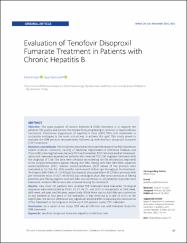| dc.contributor.author | Konya, Petek | |
| dc.contributor.author | Demirtürk, Neşe | |
| dc.date.accessioned | 2022-07-08T06:51:19Z | |
| dc.date.available | 2022-07-08T06:51:19Z | |
| dc.date.issued | 2022 | en_US |
| dc.identifier.citation | Konya, P., & Demirtürk, N. (2022). Evaluation of Tenofovir Disoproxil Fumarate Treatment in Patients with Chronic Hepatitis B. Infectious Diseases and Clinical Microbiology, 4(1), 47-55. | en_US |
| dc.identifier.issn | 2667-646X | |
| dc.identifier.uri | https://doi.org/10.36519/idcm.2022.78 | |
| dc.identifier.uri | https://hdl.handle.net/20.500.12933/1363 | |
| dc.description.abstract | Objective: The main purpose of chronic hepatitis B (CHB) treatment is to improve the
patients’ life quality and prevent the disease from progressing to cirrhosis or hepatocellular
carcinoma. Continuous suppression of hepatitis B virus (HBV) DNA with nucleoside or
nucleotide analogues is the most critical way to achieve this goal. This study aimed to
evaluate the CHB patients retrospectively followed up with tenofovir disoproxil fumarate
(TDF) treatment.
Materials and Methods: The study was planned as retrospective research by Afyonkarahisar
Health Sciences University, Faculty of Medicine, Department of Infectious Diseases and
Clinical Microbiology between January 2001 and December 2020. We evaluated all treatmentnaive and treatment-experienced patients who received TDF (245 mg/day) treatment with
the diagnosis of CHB. The data were obtained by reviewing the file information registered
in the hospital automation system. HBsAg, Anti-HBs, HBeAg, Anti-HBe, HBV DNA, aspartate
aminotransferase (AST), alanine aminotransferase (ALT) values of the patients were
evaluated at 1st, 3rd, 6th, 12th months, and 6-month follow-ups throughout the treatment.
Virological (HBV-DNA of < 50 IU/ml), biochemical (decrease below 40 IU/Ml in patients with
pre-treatment value of ALT >40 IU/ml) and serological (Anti-HBe seroconversion in HBeAg
positives and HBsAg negative and anti-HBs seroconversion in all patients) responses were
examined. Adverse effects were also assessed during the treatment.
Results: Data from 131 patients who received TDF treatment were evaluated. Virological
responses were determined as 78.6%, 81.3%, 94.2%, and 100% in the patients at 24th week,
48th week, 4th year, and 8th year, respectively. While there was no Anti-HBs seroconversion
in any patients in four years of the treatment, it was observed at a rate of 10.5% in the
eighth year. We did not determine any significant adverse effects requiring discontinuation
of the treatment in the long-term follow-up of 131 patients under TDF treatment.
Conclusion: As a result of our study, TDF was an effective and well-tolerated choice for
CHB treatment. | en_US |
| dc.language.iso | eng | en_US |
| dc.publisher | DOC TASARIM VE BİLİŞİM YAYINCILIK | en_US |
| dc.relation.isversionof | 10.36519/idcm.2022.78 | en_US |
| dc.rights | info:eu-repo/semantics/openAccess | en_US |
| dc.subject | Tenofovir disoproxil fumarate | en_US |
| dc.subject | Hepatitis b infection | en_US |
| dc.subject | Liver | en_US |
| dc.title | Evaluation of Tenofovir Disoproxil Fumarate Treatment in Patients with Chronic Hepatitis B | en_US |
| dc.type | article | en_US |
| dc.authorid | 0000-0001-5055-1220 | en_US |
| dc.authorid | 0000-0002-6186-2494 | en_US |
| dc.department | AFSÜ, Tıp Fakültesi, Dahili Tıp Bilimleri Bölümü, Enfeksiyon Hastalıkları Ana Bilim Dalı | en_US |
| dc.contributor.institutionauthor | Konya, Petek | |
| dc.contributor.institutionauthor | Demirtürk, Neşe | |
| dc.identifier.volume | 4 | en_US |
| dc.identifier.issue | 1 | en_US |
| dc.identifier.startpage | 47 | en_US |
| dc.identifier.endpage | 54 | en_US |
| dc.relation.journal | Infectious Diseases and Clinical Microbiology | en_US |
| dc.relation.publicationcategory | Makale - Uluslararası Hakemli Dergi - Kurum Öğretim Elemanı | en_US |
















